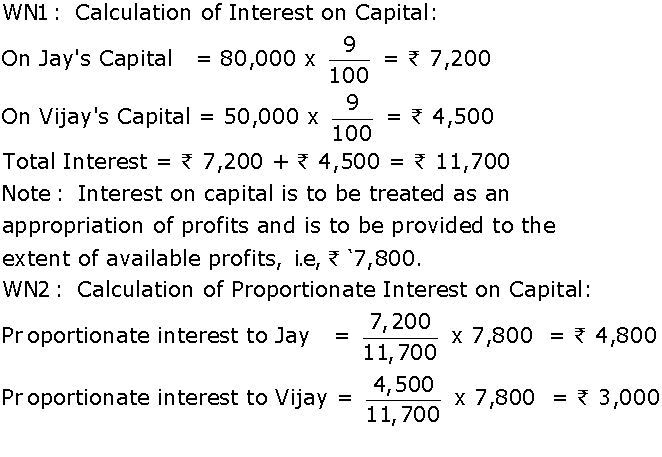Accountancy: 2015: CBSE: [Delhi]: Set – I
To Access the full content, Please Purchase
-
Q1
In the absence of partnership deed the profits of a firm are divided among the partners:
a. In the ratio of capital
b. Equally
c. In the ratio of time devoted for the firm’s business
d. According to the managerial abilities of the partners.Marks:1View AnswerAnswer:
The answer is option (b) equally.
In the absence of partnership deed, the provisions of Indian Partnership Act, 1932 applies. According to the Partnership Act, the profits and losses are to be shared equally among the partners.
-
Q2
A, B, C and D were partners in a firm sharing profits in the ratio of 4:3:2:1. On 01/01/2015 they admitted E as a new partner for 1/10 share in the profits. E brought ₹10,000 for his share of goodwill premium which was correctly recorded in the books by the accountant. The accountant showed goodwill at ₹ 1,00,000 in the books.
Was the accountant correct in doing so? Give reason in support of your answer.Marks:1View AnswerAnswer:
Accounting Standard 26 (AS-26) prescribes that goodwill is recorded in the books only when it is purchased. In this case, the accountant has shown the goodwill of the firm ₹1,00,000 as an asset in the books of the firm, which is in violation of the rules contained in the AS-26, as goodwill cannot be shown in the books until it is purchased. Hence, the accountant has adopted the wrong accounting treatment.
-
Q3
On the retirement of Hari from the firm of ‘Hari, Ram and Sharma’ the balance-sheet showed a debit balance of ₹12,000 in the profit and loss account. For calculating the amount payable to Hari this balance will be transferred
a. To the credit of the capital accounts of Hari, Ram and Sharma equally.
b. To the debit of the capital accounts of Hari, Ram and Sharma equally.
c. To the debit of the capital accounts of Ram and Sharma equally.
d. To the credit of the capital accounts of Ram and Sharma equally.Marks:1View AnswerAnswer:
The answer is option (b) to the debit of the capital accounts of Hari, Ram, and Sharma equally.
At the time of retirement of a partner, the balance of accumulated profits and losses is transferred among all the partners (including the retiring partner) in the old ratio. Here, a debit balance of ₹12,000 in the profit and loss account will be debited (being a loss) to the capital accounts of Hari, Ram and Sharma equally.
-
Q4
Kumar, Verma, and Naresh were partners in a firm sharing Profit & Loss in the ratio of 3:2:2. On 23rd January 2015 Verma died. Verma’s share of profit till the date of his death was calculated at ₹2,350. Pass necessary journal entry for the same in the books of the firm.
Marks:1View AnswerAnswer:
Journal Entry
Particulars
Dr. (₹)
Cr. (₹)
Profit & Loss suspense A/c
Dr.
2,350
To Verma’s Capital A/c
2,350
(Verma’s share of profit credited to his capital account)
-
Q5
Give the meaning of forfeiture of shares.
Marks:1View AnswerAnswer:
Forfeiture of shares implies cancellation of shares by the company issuing them, on non-payment of calls by the shareholders holding those shares.
-
Q6
Joy Ltd. issued 1,00,000 equity shares of ₹10 each. The amount was payable as follows:
On application: ₹3 per share
On allotment: ₹4 per share
On 1st & Final call: Balance
Applications for 95,000 shares were received and shares were allotted to all the applicants. Sonam to whom 500 shares were allotted failed to pay allotment money and Gautam paid his entire amount due including the amount due on first and final call on the 750 shares allotted to him along with allotment. The amount received on allotment was,
a. ₹3,80,000
b. ₹3,78,000
c. ₹3,80,250
d. ₹4,00,250Marks:1View AnswerAnswer:
The answer is option (c) ₹3,80,250
Amount received on allotment is shown below:Details
₹
Amount due on allotment
(95,000 X ₹4)
3,80,000
Less: Allotment not received
On 500 shares
(2,000)
Add: First & final call money received
in advance on 750 shares (750 X ₹3)
2,250
Net Amount Received on Allotment
3,80,250
-
Q7
State any three purposes other than ‘issue of bonus shares’ for which securities premium can be utilised.
Marks:3View AnswerAnswer:
The Companies Act of 1956 imposes certain conditions on the utilisations of amount of premium by the company. As per the Section 78 of the Companies Act of 1956, the amount of securities premium can be used by the company for several purposes.
Three of such purposes are listed below.
a. For writing off the preliminary expenses of the company.
b. For writing off the expenses, or the Commission paid or discount allowed on issue of securities or debentures of the company.
c. For buy back of its own shares. -
Q8
On 01/04/2013 Jay and Vijay, entered into partnership for supplying laboratory equipments to government schools situated in remote and backward areas. They contributed capitals of ₹80,000 and ₹50,000 respectively and agreed to share the profits in the ratio 3:2. The partnership deed provided that interest on capital shall be allowed at 9% per annum. During the year the firm earned a profit of ₹7,800.
Showing your calculations clearly, prepares ‘Profit and Loss Appropriation Account’ of jay and Vijay for the year ended 31/03/2014.
Marks:3View AnswerAnswer:
Profit & Loss Appropriation Account
Dr.
For the year ended March 2014
Cr.
Particulars
₹
Particulars
₹
Interest on Capital A/c
Profit & Loss A/c
7,800
Jay
4,800
Vijay
3,000
7,800
7,800
7,800
Working Notes:

-
Q9
‘Tractors India Ltd.’ is registered with an authorised capital of ₹10,00,000 divided into 1,00,000 equity shares of ₹10 each. The company issued 50,000 equity shares at a premium of ₹5 per share. ₹2 per share were payable with application, ₹8 per share including premium on allotment and the balance amount on first and final call.
The issue was fully subscribed and all the amount due was received except the first and final call money on 500 shares allotted to Balaram.
Present the ‘Share capital’ in the balance sheet of ‘Tractors India Ltd.’ as per Schedule VI Part I of the Companies Act, 1956. Also prepare notes to accounts for the same.
Marks:3View AnswerAnswer:
In the books of ‘Tractors India Ltd’
Balance Sheet As at……..
S.No
Particulars
Note
₹
1
Equity & Liabilities
1.Shareholder’s Fund
a. Share Capital
1
4,97,500
b. Reserve & Surplus
2
2,50,000
Notes to Accounts:
Note 1:
Particulars
₹
Share Capital
Authorised share capital
1,00,000 shares of ₹ 10 each
10,00,000
Issued share capital
50,000 shares of ₹ 10 each
5,00,000
Subscribed share capital
Subscribed and fully paid up
49,500 shares of ₹10 each fully called up
4,95,000
Subscribed but not fully paid up
500 shares of ₹10 each
5,000
Less: Call in Arrear
(2,500)
2,500
4,97,500
Note 2:
Particulars
₹
Reserve & Surplus
Securities premium reserve A/c
2,50,000
-
Q10
‘Sangam Woolens Ltd.’, Ludhiana, is the manufacturers and exporters of woolen garments. The company decided to distribute free of cost woolen garments to 10 villages of Lahul and Spiti District Himachal Pradesh. The company also decided to employ 50 young persons from these villages in its newly established factory. The company issued 40,000 equity shares of ₹ 10 each and 1,000 9% debentures of ₹ 100 each to the vendors for the purchase of machinery of ₹ 5,00,000.
Pass necessary Journal Entries. Also identify any one value that the company wants to communicate to the society.
Marks:3View AnswerAnswer:
In the books of Sangam Woolens Ltd.
Journal
Dt.
Particulars
Dr. (₹)
Cr. (₹)
Machinery A/c
Dr.
5,00,000
To Vendor A/c
5,00,000
(Being machinery purchased
From Vendor)
Vendor A/c
Dr.
5,00,000
To Equity share capital A/c
4,00,000
To 9% debentures A/c
1,00,000
(Being 40,000 shares of ₹ 10
Each and 1000 debentures of
₹ 100 each issued to vendor for
Payment of machinery)
The value that the company wants to communicate to the society is helping the poor and needy; and generating employment in rural area.



